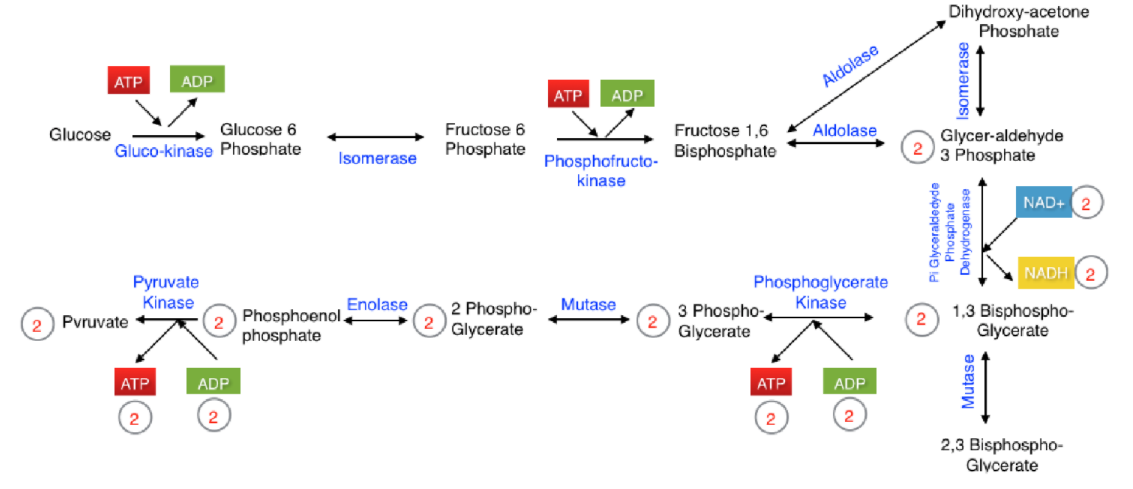
The site of EMP pathway in cell is
(A) Peroxisome
(B) Cytoplasm
(C) Matrix of mitochondria
(D) Inner membrane of mitochondria
Answer
489.3k+ views
Hint: EMP pathway is the most commonly used type of glycolysis. The full form of EMP pathway is Gustav Embden, Otto Meyerhof and J. Parnas pathway since they gave the scheme for glycolysis. It is the first process that takes place in the respiration.
Complete step by step answer:
Glycolysis takes place aerobically or anaerobically but it doesn’t involve molecular oxygen. It is the sequence of catalytic reactions that are irreversible in nature. In this process the complex molecules like glucose, fructose etc. break down into the simpler compounds like pyruvate, pyruvic acid and hydrogens with the certain amount of energy released. Hence it is known as glycolysis. It is a common pathway that occurs in both aerobic and anaerobic respiration. The energy released from the glycolysis process is in the form of ATP (Adenosine triphosphate) and NADH.

The pyruvate that is produced as the result of glycolysis enters into the citric acid cycle where it diffuses in the mitochondria. Glycolysis takes place in the cytosol of the cells of both prokaryotic and eukaryotic cells of the living organisms. Cytosol is the liquid component of the cytoplasm. Hence the site of the EMP pathway in the cell is cytoplasm.
Thus, the option (B) is correct.
Note: Glycolysis or EMP pathway takes place in two phases. They are preparatory phase and pay off phase. The preparatory phase deals with the first five of ten catalytic reactions. And the payoff phase deals with the last five reactions.
Complete step by step answer:
Glycolysis takes place aerobically or anaerobically but it doesn’t involve molecular oxygen. It is the sequence of catalytic reactions that are irreversible in nature. In this process the complex molecules like glucose, fructose etc. break down into the simpler compounds like pyruvate, pyruvic acid and hydrogens with the certain amount of energy released. Hence it is known as glycolysis. It is a common pathway that occurs in both aerobic and anaerobic respiration. The energy released from the glycolysis process is in the form of ATP (Adenosine triphosphate) and NADH.

The pyruvate that is produced as the result of glycolysis enters into the citric acid cycle where it diffuses in the mitochondria. Glycolysis takes place in the cytosol of the cells of both prokaryotic and eukaryotic cells of the living organisms. Cytosol is the liquid component of the cytoplasm. Hence the site of the EMP pathway in the cell is cytoplasm.
Thus, the option (B) is correct.
Note: Glycolysis or EMP pathway takes place in two phases. They are preparatory phase and pay off phase. The preparatory phase deals with the first five of ten catalytic reactions. And the payoff phase deals with the last five reactions.
Latest Vedantu courses for you
Grade 10 | MAHARASHTRABOARD | SCHOOL | English
Vedantu 10 Maharashtra Pro Lite (2025-26)
School Full course for MAHARASHTRABOARD students
₹33,300 per year
Recently Updated Pages
Master Class 11 Economics: Engaging Questions & Answers for Success

Master Class 11 Business Studies: Engaging Questions & Answers for Success

Master Class 11 Accountancy: Engaging Questions & Answers for Success

Master Class 11 English: Engaging Questions & Answers for Success

Master Class 11 Computer Science: Engaging Questions & Answers for Success

Master Class 11 Maths: Engaging Questions & Answers for Success

Trending doubts
State and prove Bernoullis theorem class 11 physics CBSE

1 ton equals to A 100 kg B 1000 kg C 10 kg D 10000 class 11 physics CBSE

State the laws of reflection of light

One Metric ton is equal to kg A 10000 B 1000 C 100 class 11 physics CBSE

Difference Between Prokaryotic Cells and Eukaryotic Cells

1 Quintal is equal to a 110 kg b 10 kg c 100kg d 1000 class 11 physics CBSE




